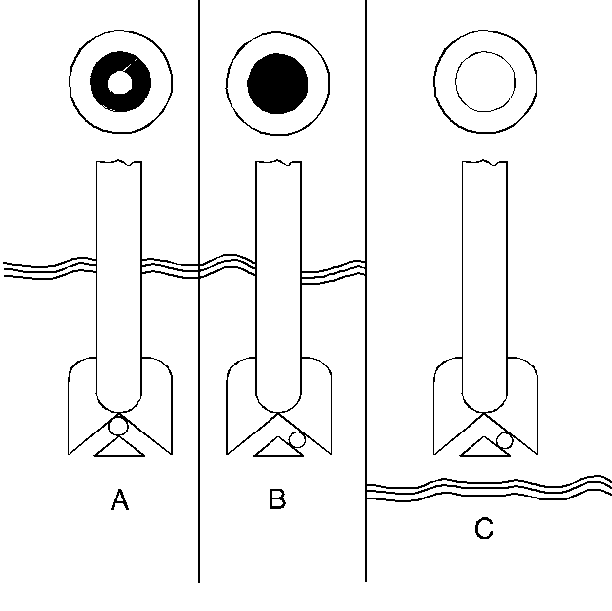Caution: Batteries generate hydrogen gas, which is extremely flammable and may
explode violently if ignited by a spark or a flame. Battery acid is extremely
corrosive and causes severe personal injury if the acid comes into contact
with the skin, and blindness if the acid comes into contact with the eyes.
In order to avoid severe personal injury, use extreme caution
when servicing the battery or battery-related components.
Charging Time Required
The time required to charge a battery will vary depending upon the following
factors:
| • | The size of the battery -- A completely discharged, large,
heavy-duty battery requires more than twice the recharging time as a
completely discharged, smaller capacity battery. |
| • | The temperature -- A longer time is needed to charge any
battery at -18°C (0°F) than at 27°C (80°F). When a fast
charger is connected to a cold battery, the current accepted by the battery
is very low at first. As the battery warms, the battery accepts current
at a higher rate. |
| • | The charging capacity -- The higher the charger
amperage, the faster the battery will charge. |
| • | The state-of-charge -- A completely discharged battery requires
more than twice as much charge time as a half charged battery. Because the
electrolyte is nearly pure water and a poor conductor in a completely discharged
battery, the battery accepts very low current at first. Later, as the charging
current causes the electrolyte acid content to increase, the charging current
also increases. |
Battery Charging Preliminary Inspections
| • |

Batteries showing a green
dot in the hydrometer (A) do not need to be charged unless they have just
been discharged (such as extended engine cranking). |
| • | Batteries showing a black or dark dot in the hydrometer (B) can
be charged. |
| • | Do NOT charge a battery that is frozen. Replace any frozen battery.
Refer to
Battery Replacement
. |
| • | To keep charge time to a minimum, use a charger capable of an
end voltage of at least 16 V and equipped with a voltmeter that is
accurate to within 1 percent. |
| • | The ambient temperature should be 15-38°C (60-100°F).
A battery that is extremely cold will not accept measurable current for several
hours after starting the charger. |
| • | Ensure that the charging area has proper ventilation. |
Charging the Battery in the Vehicle
Caution: Unless directed otherwise, the ignition and start switch must be in the OFF or LOCK position, and all electrical loads must be OFF before servicing
any electrical component. Disconnect the negative battery cable to prevent an electrical spark should a tool or equipment come in contact with an exposed electrical terminal. Failure to follow these precautions may result in personal injury and/or damage to
the vehicle or its components.
| • | Turn off the battery charger. |
| • | Connect the battery charger positive lead to the battery positive
terminal. |
| • | Connect the battery charger negative lead to a solid engine ground. |
| | Notice: Do not use boost, jump start, crank, or equivalent setting for prolonged
charging of batteries. Undesirable and potentially dangerous spewing of gases
or electrolyte through the vent holes may occur.
|
| • | Turn the battery charger on. A 40-50 ampere charging level
is recommended for a discharged battery. |
| • | Inspect the battery every 30 minutes and perform the following
inspections: |
| • | If the battery feels hot, 52°C (125°F), or if gassing
or spewing of the electrolyte through the battery vent holes occurs, discontinue
charging the battery or reduce the charging rate in order to eliminate the
battery gassing or electrolyte from spewing. |
| • | Tap the hydrometer lightly to dislodge any air bubbles which may
cause a false hydrometer reading. |
| • | Stop charging the battery within one hour after the green dot
appears in the hydrometer. |
Charging the Battery out of the Vehicle
Tools Required
GM P/N 12303040 (ST
1201) Battery Side Terminal Adapters
Caution: Unless directed otherwise, the ignition and start switch must be in the OFF or LOCK position, and all electrical loads must be OFF before servicing
any electrical component. Disconnect the negative battery cable to prevent an electrical spark should a tool or equipment come in contact with an exposed electrical terminal. Failure to follow these precautions may result in personal injury and/or damage to
the vehicle or its components.

- Install the GM P/N 12303040
to the battery terminals.
- Connect the battery charger positive lead to the battery positive
terminal.
- Connect the battery charger negative lead to the battery ground
(negative) terminal.
Notice: Do not use boost, jump start, crank, or equivalent setting for prolonged
charging of batteries. Undesirable and potentially dangerous spewing of gases
or electrolyte through the vent holes may occur.
- Turn the battery charger on. A 40-50 ampere charging level
is recommended for a discharged battery.
- Inspect the battery every 30 minutes and perform the following
inspections:
| • | If the battery feels hot, 52°C (125°F), or if gassing
or spewing of the electrolyte through the battery vent holes occurs, discontinue
charging the battery or reduce the charging rate in order to eliminate the
battery gassing or electrolyte from spewing. |
| • | Tap the hydrometer lightly to dislodge any air bubbles which may
cause a false hydrometer reading. |
| • | Stop charging the battery within one hour after the green dot
appears in the hydrometer. |
- Test the battery. Refer to
Battery Check
.


